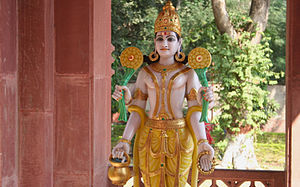Keshava nama
The Keshava nama ( Sanskrit केशव नाम keśava nāma ) are 24 names with which the highest god Vishnu is referred to among Vaishnavas .
etymology
Keshava is the first name of Vishnu. The Keshava Nama are often just called Chaturvimshati Nama (चतुर्विंशति नाम, caturviṃśati nāma). Keshava is the derivative of Keshi , a demon that was killed by Krishna .
background
The 24 forms of Vishnu were probably first developed in the Mahabharata . His rupa (shape) and its forms are mentioned for the first time in the Agni-Purana , in the Rupamandana and in the Aparajitaprichchha . They also appear in the Vaishnava Puranas such as the Bhagavata and the Vishnu Purana . The Keshava Nama were thus already established during the early epoch of Hinduism .
use
In Hinduism, the Keshava Nama are most sacred to Vaishnava and are recited and praised at the beginning of all Vedic puja . In the ritual of Achamana , the holy names are used to cleanse the body, whereby the various parts of the body are touched at the same time while reciting. They also play a major role in devotions of the bhakti and were devotedly sung by bhaktas such as Purandara Dasa . Acharnas for Vishnu are incomplete without reciting his holy names.
iconography
The 24 holy names of Vishnu are represented by upright statues of Vishnu, each of which holds his attributes wheel ( chakra ), conch ( shankha ), club ( gada ) and lotus ( padma ) in one of his four hands. The 24 statues each symbolize one of the visible appearances of Vishnu. They differ from each other only in the different order of the attributes in the four hands, with each individual statue having its own name with individual characterization.
The 24 names
Keshava
The arrangement of its attributes is (starting from the right upper arm, left upper arm, right lower arm, to the left lower arm) conch, wheel, lotus, club. Keshava (or Kaishava) is made up of the three main deities Brahma (creation), Vishnu (preservation) and Shiva (destruction) (where K stands for Brahma, A for Vishnu, isha for Shiva and above all for Svarupa (form)) . He is thus master of creation, maintenance and dissolution of the universe. Keshava has beautiful, soft, thick, black hair ( Kesha ) and attracts the rays of light within the solar system. His wife is Sri , his skin color is golden and his element ( Tattva ) is heaven or space ( Akasha ).
Narayana
The arrangement of the four attributes of Narayana is lotus flower, club, conch horn and wheel of fire. Its name is derived from Nara (water) and Ayana (resting place), which is why the Supreme Lord Vishnu, who dwells on the ocean of causes, is also called Narayana. It is both the ultimate refuge (Ayana) of all living beings ( Nara ) and at the same time resides in the individual souls ( Jivas ). Narayana knows no flaw, but is complete in all its properties (gunas). Nara also means human, which is why Narayana, as the highest being, is the place of protection for all human beings. His wife is Lakshmi , his complexion is white and his element is the gaseous air ( Vayu ).
Madhava
The arrangement of the attributes of Madhava is the wheel of fire, conch shell, club, lotus flower. He is the Lord of Knowledge and the husband ( Dhava ) of Lakshmi, the goddess of wealth and prosperity. As a Lakshmipathi, he is married to Ma (or Mahalakshmi ), the mother of the universe. Madhava is also called Jnanadhipathi and can only be known through Madhu-vidya (where Ma means knowledge or realization). The name Madhava is also explained by its membership of the Madhu (or Yadu) tribe. Furthermore, Madhava is the Lord of Brahma Vidya and in turn possesses all the attributes of the Goddess of Wealth. He is the source and distributor of loving grace ( Ananda ). He has black skin and his element is fire or light ( Vahni ). His wife's name is also Kamala.
Govinda
Govinda is the primordial Lord and the cause of all causes. The arrangement of its attributes is club, lotus flower, fire wheel and conch shell. His name is derived from go (cow, beef) and vinda (protector), so he is the protector of the cows and in the broader sense of the earth and the Vedas . Govinda invigorates the senses. He owns Golokadhama, the kingdom of Goloka, and is the supreme giver of grace, happiness and bliss. Govinda protects and sustains the universe whose energy source he is. The energy of the sun , which fills our world with light, also emanates from him. His wife is Padma , his skin color is crystal white and his element is water ( Apa ).
